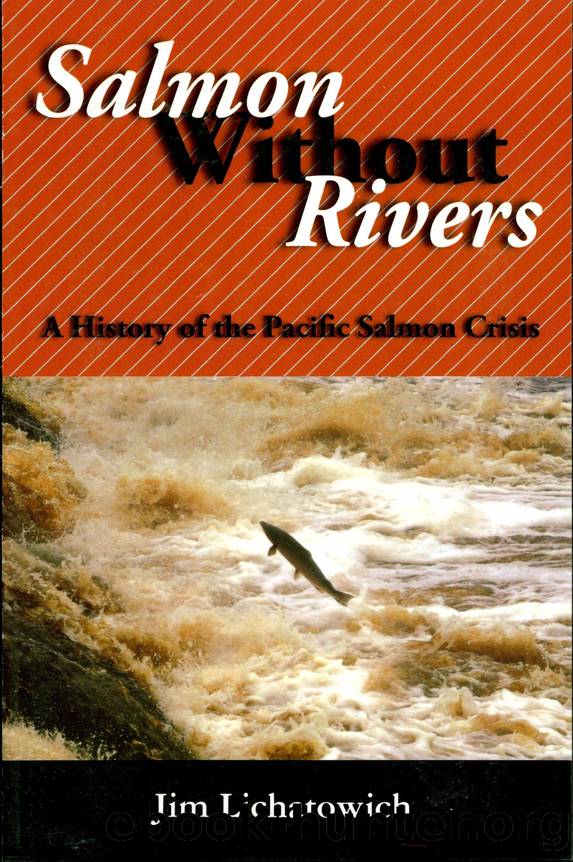Salmon Without Rivers by James A. Lichatowich

Author:James A. Lichatowich [Lichatowich, James A.]
Language: eng
Format: epub
ISBN: 9781597268899
Publisher: Island Press
Published: 2013-02-13T00:00:00+00:00
Science and Salmon Management
Less than two years after attending the 1925 Seattle meeting, Henry OâMalley, the U.S. fish commissioner, assembled his scientific staff to discuss the need for a new approach to fisheries management. It was the first time the Division of Scientific Inquiry had come together in the bureauâs forty-five-year history.
OâMalley opened the meeting with what amounted to a confession of failure. In a typical bureaucratic softening of the obvious, he told his scientists, âI should not care to say that the Bureauâs work had amounted to nothing, but we must conclude that our efforts have not been sufficient to maintain the fisheries in their former state of productiveness.â12
OâMalley went on to explain that the declining fisheries had brought about a broad change of attitude. Congress, which in the past had wanted to fund only hatcheries, was now willing to fund biological investigations to gain the information needed to reverse the slide. With apparent enthusiasm, OâMalley proclaimed that the time when fisheries investigators were looked upon as odd âbug huntersâ was now over.
As the leader of the Division of Scientific Inquiry, Elmer Higgins continued with OâMalleyâs theme. Fifty years ago, he told the scientists, North America was young, with virgin natural resources. Those who had worked to develop the nationâs seemingly unlimited resources simply had not considered the possibility of depleted fisheries. Then Higgins went straight to the heart of the matter, explaining that âthe great promise and popular success of fish culture induced a complacent confidence, as it was believed that the control of the fish supply was in easy grasp.â13 Higgins reminded the scientists of the outlandish claims of success made by George Brown Goode fifty years earlier. âHere the fish culturist comes in with the proposition that it is cheaper to make fish so plentiful by artificial means, that every fisherman may take all he can catch, than to enforce a code of protection laws. The salmon rivers of the Pacific slope. . . and the shad rivers of the East and the whitefish fisheries of the lakes are now so thoroughly under control by fish culturists that it is doubtful if anyone will venture to contradict his assertion.â 14 Higgins proceeded to explain what had actually happened:
How well founded was this faith in the all-effectiveness of fish culture in maintaining or restoring the fisheries in the face of all possible destructive influences may be seen by the fate of the three great fisheries that he [Goode] chose as illustrations. Despite fifty-five years of artificial propagation the Pacific salmon fishery has declined alarmingly, the pack in Puget Sound in 1924 amounting to but 12% of the peak production in 1913. The shad fisheries of the East Coast declined, on the whole, 74% from 1896 to 1923, and now are totally destroyed in many of our rivers. The whitefish fisheries of the lakes, despite an annual distribution of 409,000,000 eggs and fry per year, have declined in yield from first place in 1880 to fourth place in 1922, with a yield only slightly greater than that of suckers.
Download
This site does not store any files on its server. We only index and link to content provided by other sites. Please contact the content providers to delete copyright contents if any and email us, we'll remove relevant links or contents immediately.
Man-made Catastrophes and Risk Information Concealment by Dmitry Chernov & Didier Sornette(5922)
The Revenge of Geography: What the Map Tells Us About Coming Conflicts and the Battle Against Fate by Kaplan Robert D(4036)
Zero Waste Home by Bea Johnson(3781)
COSMOS by Carl Sagan(3554)
Good by S. Walden(3488)
In a Sunburned Country by Bill Bryson(3486)
The Fate of Rome: Climate, Disease, and the End of an Empire (The Princeton History of the Ancient World) by Kyle Harper(3003)
A Wilder Time by William E. Glassley(2818)
Camino Island by John Grisham(2763)
The Ogre by Doug Scott(2631)
Organic Mushroom Farming and Mycoremediation by Tradd Cotter(2628)
Human Dynamics Research in Smart and Connected Communities by Shih-Lung Shaw & Daniel Sui(2466)
Energy Myths and Realities by Vaclav Smil(2439)
The Traveler's Gift by Andy Andrews(2409)
9781803241661-PYTHON FOR ARCGIS PRO by Unknown(2323)
Inside the Middle East by Avi Melamed(2305)
Birds of New Guinea by Pratt Thane K.; Beehler Bruce M.; Anderton John C(2226)
A History of Warfare by John Keegan(2186)
And the Band Played On by Randy Shilts(2130)
